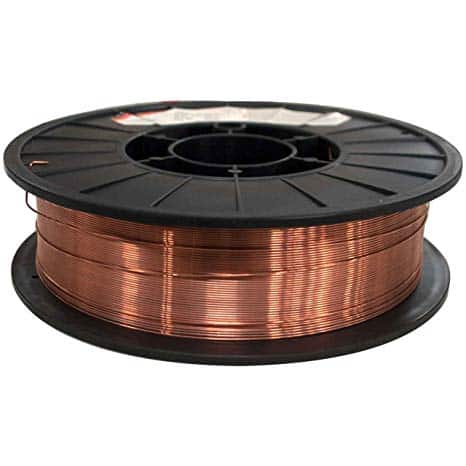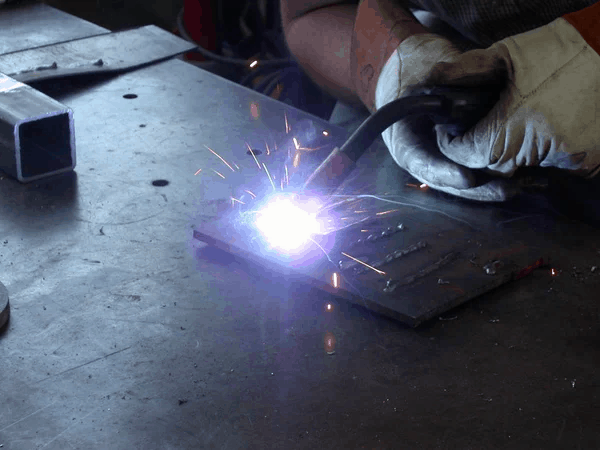Metal inert gas (MIG) is a welding technique in which you have a consumable electrode producing an electric arc with the work piece metal. This electric arc heats the metallic surfaces hence joining them together. The wielding gun has a place where the inert gas flows hence protecting the weld from contamination. MIG is either automatic or semi-automatic. The inert gases is a mixture of argon and carbon dioxide. The MIG can run on either AC or DC.
MIG wire thickness
The general rule in welding is that a wire with a thin diameter should be used for a thin metal and vice versa but this rule is a bit vague because thinness and thickness is relative. When defining MIG wires thin is defined as anything that has a thickness of less than 1/8 inches. According to the AWS classification the ER70S-3 is all purpose while the ER70S-6 is ideal for dirty or rusty steel due to its high content of deoxidizers. Most home applications will work fine with a MIG wire diameter of .030-inches. If you are thinking of welding thinner metals then a MIG wire diameter of .023 inches would be ideal. Thicker metals would need a MIG wire diameter of .035 or .045- inches.
Ideal shielding gas

Once you have the right wire the next step is to select the right shielding gas mixture. For most all-purpose welds that are carbon steel related you can use a mixture of 75% argon and 25% carbon dioxide. If you want more penetration then go for 100% carbon dioxide. The downside to this is you get more spatter and a rougher bead.
Wire sticking out
When MIG welding maintain a stick-out length of 3/8 inches, the sticking out length is unmelted electrode that is protruding from the contact tube tip. If you notice irregular arc sounds then know your stickout is longer than recommended for MIG welding.
Voltage and amperage
Your metal thickness, joint configuration, metal type, shielding gas, welding position and wire diameter speed all contribute to the amperage and voltage you use for your MIG welding. You can find some charts that pinpoint the exact amperage to use for particular metals.
Travel angle
This is the angle of the gun in a perpendicular position. The travel angle will influence spatter. For most welding procedures be on the lookout for a travel angle of 5 to 15 degrees, higher degrees of over 25 lead to more spatter, general arc instability and less penetration.
Push or pull
How you handle the MIG gun will determine the kind of results you get. When you push the gun away from the weld puddle – a technique also called forehand technique or push –you experience lower penetration rates and a flatter bead as the force of the arc is moved away from the weld puddle. Alternatively, you can use the backhand or drag technique that allows you to direct the weld gun at the weld puddle and hence dragging it away from the deposited metal. This is also called the pull or trailing technique. Dragging you weld gun in this way produces deeper penetration the buildup of a narrower bead.
Working angle
When we talk of the working angle we are referring to the positioning of the MIG gun relative to the welding joint angle. If you are doing a butt weld then the position the weld gun at a 90-degree angle to the workpiece. Include a travel angle of 5 to 15 degrees. This helps direct the filler material straight to the joint. With the technique you are able to fill large gaps or even make multiple passes. To avoid an undercut slightly pause at the side of the weave bead.
If you are welding a Lap joint ensure the working angle is at 60 to 70 degrees. Note you can increase the angle for thicker metals.
Also known as the fillet weld, the T-joint allows you to keep your gun at an angle of 45 degrees. However, this will change if you are making multiple weld passes as you will need to change this angle. This is to avoid undercuts and uneven weld beads.
Handling MIG welding in horizontal, vertical, and overhead positions

During welding you have to take into account the influence of gravity on welding. This necessitates one to drop the work gun angle by about 0 to 15 degrees. This helps prevent sagging of the filler metal or it rolling over to the bottom of the weld joint. In all these, the travel angle remains constant. Use weave beads whenever you are making multiple passes on thick metals. When it comes to the welder machine voltage and amperage you may need to lower them slightly than for welding flat positions.
One of the most challenging welding bit is welding vertical positions. Gravity works against you and this necessitates one to spend a bit of time in pre-welding setting up. You may also need to reduce the amperage and voltage by 10 to 15 percent. Due to the faster travel speed the arc penetrates less hence making vertical welding ideal for thin metal sheets. During vertical welding of joint begin from the top to the bottom. It is also recommended to place thin sheets in the vertical position to help prevent excessive melt troughs. In vertical welding you may face some burn-through; the ideal way for welding is to direct the wire away from the weld puddle. Alternatively, you can use the vertical up technique in which case you begin at the bottom of the joint and move all the way up. This method is ideal for thicker metals of ¼ inches and more as it offers better penetration. The travel angle for the MIG gun should be between 5 to 15 degrees from the perpendicular position.
If you are planning on overhead welding then the best is push, drag or perpendicular gun technique. The problem with this is gravity causes the weld metal to fall out so your travel speeds should be fast enough to counteract this. Ensure that you do not have weave beads that far too wide apart. To keep your puddle small and controllable lower you voltage and amperage.
How Porosity Influences MIG wire welding
Porosity is one of the key factors to consider when you are welding. It is defined by atmospheric oxygen coming into contact with your weld, poor weld soundness, poor shielding gas and when you base metal becomes contaminated with carbon from the weld metal to form carbon monoxide. As the weld pool cools down some of these CO bubbles become trapped in the weld forming porosity pores. The ideal MIG wire should have less hydrogen in the deposit. Metal welding with low porosity offers good fusion and is free from cracking.
To control porosity the MIG wire will have a combination of deoxidizers that interact with the weld puddle to minimize the release of CO. Various MIG manufacturers will add certain elements to their spool arc wires so that during welding you have a harmless slag. Some of the deoxidizers they will use include Silicon, Manganese, Zirconium, and Aluminum. The most powerful of these are titanium, aluminum, zirconium which are up to five times more effective than the commonly used silicon and manganese. But, also comes at a price. When choosing the ideal MIG wire be careful to choose one with the right content of deoxidizers. When you have more of these you affect puddle fluidity and bead shape. The aluminum, titanium and zirconium deoxidizers wires make the weld puddle to appear sluggish and stiff. This makes them ideal for small diameter pipe welding.
Fluidity influences welding in a great deal as helps the fluid puddles to wet out smoothly along the edges and this helps to produce smooth, flat bead shape. Fluidity is vital during multi-pass welds where instances of lack of fusion can cause poor bead shape. Note that if you have excessive puddle fluidity you will experience welding difficulties in out-of-position welding or in case you are doing concave horizontal fillets.
You choice of the welding gas is very important in the kind of welds you produce. If you use more of carbon dioxide you are going to experience more turbulence for the wire to base metal transfer. Here you will experience more spatter loss and the weld creates a more crowned bead. If you want a more stable and uniform wire-to-base plate metal transfer then go for situations where the argon shield gas is more. Here you have less spatter and the formation of well-shaped beads. Note than increasing your welding machine arc voltage will increase your puddle fluidity and lead to flatter weld beads. It will also increase the spatter and increase edge wetting.
Conclusion
Making the right welds with your MIG gun requires practice. There are many factors that influence the kind of joints you get like wire travel speed, shielding gas composition to amperage and voltage. When welding you also need to get the right travel angle for the best results. MIG is preferred by many welders due to its ease of use. A novice can learn welding in minutes but you need to factor in having the right wire thickness.

